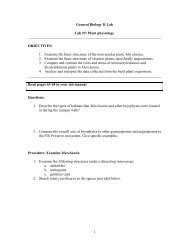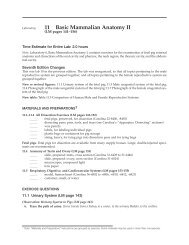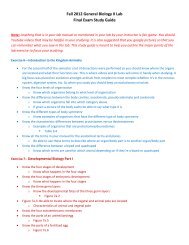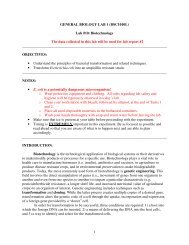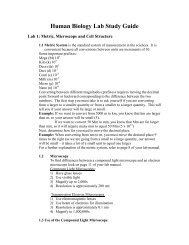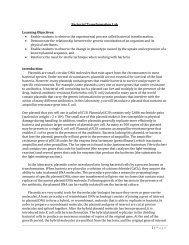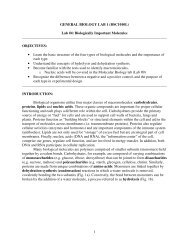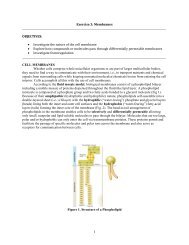Lab #7: Introduction to the Kingdom Animalia Objectives: 1 ...
Lab #7: Introduction to the Kingdom Animalia Objectives: 1 ...
Lab #7: Introduction to the Kingdom Animalia Objectives: 1 ...
Create successful ePaper yourself
Turn your PDF publications into a flip-book with our unique Google optimized e-Paper software.
3. Out of all <strong>the</strong> organisms you examined, is <strong>the</strong>re a particular pattern between <strong>the</strong><br />
organisms that have bilateral symmetry Radial symmetry Make sure <strong>to</strong> consider<br />
morphology.<br />
Task 4: Developmental patterns in bilateral animals: Pro<strong>to</strong>s<strong>to</strong>mes and Deuteros<strong>to</strong>mes<br />
Bilateral animals follow two major patterns of embryonic development. Based on <strong>the</strong>se patterns<br />
<strong>the</strong>y are classified as ei<strong>the</strong>r deuteros<strong>to</strong>mes or pro<strong>to</strong>s<strong>to</strong>mes. In deuteros<strong>to</strong>mes, <strong>the</strong> blas<strong>to</strong>pore (first<br />
embryological opening) becomes <strong>the</strong> anus, while in pro<strong>to</strong>s<strong>to</strong>mes <strong>the</strong> blas<strong>to</strong>pore becomes <strong>the</strong><br />
mouth. Also, cleavage, <strong>the</strong> initial process of cell development after a zygote is formed is<br />
different in <strong>the</strong> two lineages: In pro<strong>to</strong>s<strong>to</strong>mes, cleavage is spiral, while it is radial in<br />
deuteros<strong>to</strong>mes.<br />
The separation of <strong>the</strong> metazoans (multicellular animals) in<strong>to</strong> two separate lineages, suggests an<br />
evolutionary divergence of <strong>the</strong> bilateral body plan. This suggests that deuteros<strong>to</strong>mes and<br />
pro<strong>to</strong>s<strong>to</strong>mes are separate, monophyletic lineages. For fur<strong>the</strong>r information, please look at table<br />
40.1 (pg. 441) in your lab manual.<br />
Examine <strong>the</strong> animals noted under <strong>the</strong> “Example species” below and answer <strong>the</strong> questions below<br />
<strong>the</strong> table.



